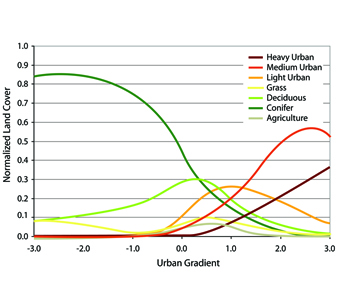 Urban development across the United States dramatically transforms the natural landscape and its ecological function. It fragments and impairs habitat, simplifies and homogenizes species composition, alters hydrological systems, and modifies energy flows and nutrient cycling. In turn, these changes affect the ability of ecosystems to support human functions, the quality of urban environments, and ultimately human well-being.
Urban development across the United States dramatically transforms the natural landscape and its ecological function. It fragments and impairs habitat, simplifies and homogenizes species composition, alters hydrological systems, and modifies energy flows and nutrient cycling. In turn, these changes affect the ability of ecosystems to support human functions, the quality of urban environments, and ultimately human well-being.
While is known that different patterns of urban development have predictably different impacts on ecosystem functioning, the exact effects of different forms, densities, and levels of urban connectivity are not well known; nor is the way these interactions vary from place to place. For example, compact development patterns are typically associated with lower impacts on the natural surroundings. But the complex interactions between the patterns of built and natural landscapes in urbanizing regions are actually not well understood. Despite much debate on the ecological impact of alternative urban forms, the proposed relationships between urban patterns and ecosystem functions are still only hypotheses.
In an effort to provide designers and planners with insight on the functioning of coupled human and natural systems, a new research collaboration between the Urban Ecology Research Laboratory (UERL) at the University of Washington and the Global Institute of Sustainability at Arizona State University is developing the concept of ecological signatures.1 The effort is aimed at quantifying and comparing the actual ecological effects of different development patterns using established scientific tools. This knowledge is essential if future design and planning will be able to lower the impact of new development on a regional scale. Our contention is that the complex interactions between human and biophysical processes at a variety of scales give rise to distinctive landscape patterns. We call these “ecological signatures.” We further propose that the challenge for urban designers and planners in coming decades will be to understand how these patterns emerge, evolve and affect ecosystem dynamics in a much more accurate and fine-grained way.